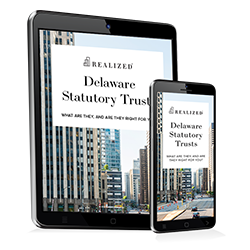
Entering a Delaware Statutory Trust (DST) is a powerful investment strategy that provides tax-deferral benefits, enhanced diversification, and truly passive income. Before you commit to this route, however, you may have various questions regarding certain aspects of the DST, such as the establishment timeline. How long does it take to set up a Delaware Statutory Trust? Is there a faster way to go about it? Realized 1031 shares the answers to these questions below to help you out.
Why Timing Matters in the DST Process
Understanding the timeline in DST investing is crucial when combined with 1031 exchanges. Qualifying DSTs allow investors to acquire beneficial interests in exchange for the proceeds from the relinquished property sale. However, the 1031 exchange itself is bound to the 180-day timeline as required by the IRS. As such, investors must complete the entire transaction within this period, or they lose the tax-deferred status and get a big tax hit. Understanding how long it takes to set up or join a DST can determine whether this strategy fits your investment plan.
How Long Does It Take To Set Up a DST?
We need to establish one fact before discussing how long the DST setup process is: it’s highly improbable for an individual investor to establish a DST on their own. This investment vehicle isn’t just a simple trust. It’s a complex legal entity codified by Delaware Law, and there are many aspects to this investment vehicle, like property acquisition or SEC compliance, that an individual won’t be able to handle.
Given this fact, the most common entity that sets up a DST is the sponsor. The process usually goes like this.
- Structuring the DST (1 – 2 Weeks): The sponsor drafts the trust agreement and begins creating investment strategies, governance rules, and guidelines for property acquisitions. At this stage, the sponsor engages with the right experts to ensure that the structure it’s creating is compliant with IRS rules.
- Acquiring Properties (1 – 2 Months or Longer): After establishing the DST structure, the sponsor begins to identify, vet, and acquire properties. This stage may go longer due to factors like complex financing requirements.
- SEC and Investor Compliance (2 – 4 Weeks): After acquiring properties, the sponsor creates essential documents like the private placement memorandum (PPM) and files securities documents to comply with SEC requirements. The PPM will serve as the document detailing all that the investors need to know about the DST offering.
Overall, the process may take an average of 120 days. Factors like property negotiations, financing, and regulatory compliance can affect this timeline.
Investing in a DST: The Faster Option
Instead of establishing a DST on your own (a highly impractical move), the faster method is to find current DST offerings to enable your 1031 exchange. These offerings are already pre-packaged, making the investment timeline much faster and more streamlined.
1. Consultation and Selection (1 – 2 Weeks)
The first step is to work with a broker who can access networks or platforms listing DST offerings. Once you’ve found ones that appeal to you, review the underlying properties, assess risk, and evaluate the potential income or return on investment. At this stage, you may submit your list of identified DST offerings to your qualified intermediary.
2. Subscription of Documents (1 – 5 Days)
This phase is when you begin engaging with the DST sponsor. You'll need to review the PPM, sign the subscription documents, and complete the accreditation checks to ensure that you’re an eligible investor. At this point, you’ve officially begun the process of joining the DST.
3. Funding and Closing (3 – 10 Days)
After you’ve finalized the subscription documents and proven your accredited status, the next and final phase is closing the transaction. Your qualified intermediary will transfer the funds to the DST sponsor, and you now own fractional interests in the DST.
Ideally, investing in a DST should take around one to three weeks. Some investors may take a month or more, especially when they’re more meticulous when assessing DST sponsors and the underlying properties. However, this process rarely lasts 180 days. As such, joining a DST instead of establishing one becomes the more practical approach, especially when you’re under 1031 exchange deadlines.
To minimize the chances of delays, proper planning is key. Make sure to identify properties within the 45-day deadline. Prepare the right documents ahead of time as well. That way, you can streamline the transaction and avoid unnecessarily stretching the timeline.
Wrapping Up: The DST Timeline Basics
Joining a DST as an investor can be a quick process when planned correctly. You can complete the entire process within a month, making this strategy ideal for those under the strict deadlines of 1031 exchanges. Knowing each step and how long they take will help you go through the transaction with confidence and meet the deadlines without any issues.
Sources:
https://www.sec.gov/resources-small-businesses/capital-raising-building-blocks/accredited-investors



